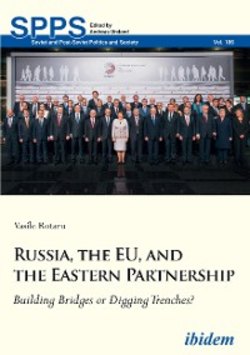Читать книгу Russia, the EU, and the Eastern Partnership - Vasile Rotaru - Страница 5
Foreword
ОглавлениеSince the dissolution of the Soviet Union, EU-Russia relations have witnessed a sinusoidal evolution. The cycles of rapprochement (e.g. the beginning of the ‘90s, the Medvedev presidency) have been followed by periods of tension (e.g. the Primakov tenure as foreign minister, Putin’s third presidential term). The mutual trust between the two actors has varied accordingly.
In the first years of post-Soviet Russia the relations with the EU/EC reached the highest level. Moscow had abandoned the bellicose rhetoric and was showing great willingness to integrate into the Western community, on the latter’s conditions. From a rival and competitor Russia had become a listening pupil of the US and Western Europe. During the recent Ukrainian crisis, in contrast, Moscow’s relations with Brussels deteriorated as had never happened before, during the post-Soviet period. Mutual accusations of violation of international law have been followed by mutual sanctions. The EU-Russia summits and the negotiations of the new Partnership and Cooperation Agreement have been suspended.
By and large, the disagreements over the past 25 years between the EU and Russia have been caused by three main elements: normative issues, energy relations and the shared neighbourhood—the latter being particularly present on Brussels-Moscow agenda after the launch of the Eastern Partnership (EaP) in 2009.
The former Soviet space is at the core of Russian foreign policy and the rapprochement of any other actor towards this region is regarded with high suspicion. Even the syntagm used for designation of the countries laying between Russia and the EU (Belarus, Moldova, Ukraine, Georgia, Armenia and Azerbaijan, which are included in the EaP) gave grounds for dispute. Brussels’s proposed term ‘common neighbourhood’ was opposed by Moscow at first on the ground that it could have hinted some challenge to its sphere of influence, preferring instead the expressions ‘countries adjacent to Russia’ and ‘countries adjacent to the EU’ (Haukkala 2010: 137). This way, it sought to specify the separate nature of the links that Russia and the EU have with their respective neighbourhoods.
In this book, we will use the syntagm ‘common neighbourhood’ for referring to six former Soviet countries: Armenia, Azerbaijan, Belarus, Georgia, Moldova and Ukraine, without implying any subjective position of either Russia or the EU. We will use as well the term ‘near abroad’ (ближнее зарубежье, [blizhneye zarubezhye]) as a synonym for the former Soviet space. We are aware that this syntagm was coined by the Russian foreign minister Andrey Kozyrev (1990–1996) in the early 1990s in order to denote a special droit de regard for Moscow in the former Soviet republics (Martinsen 2002: 2). By using it here, we do not suggest that the Kremlin has special rights in the former Soviet space. Rather we emphasise specifically Russian perspectives towards this area. As we focus only on six former Soviet republics, Armenia, Azerbaijan, Belarus, Georgia, Moldova and Ukraine, we will here de facto apply ‘near abroad’ only to this area.
This book comprises updated versions of the author’s journal articles and some revised fragments from his previous books The Eastern Partnership: A Turning Point in EU-Russia Relations? (Military Publishing House, Bucharest, 2014) and Between Integration and Intervention: Russia and the European ‘Near Abroad’ after 2009 (Military Publishing House, Bucharest, 2016). As the title suggests, the book analyses EU-Russia relations with a particular emphasis on the impact of the Eastern Partnership (EaP) on Moscow’s relations with Brussels and the former Soviet space.
The book is divided into two main parts. The first part starts by assessing the differences between Moscow’s and Brussels’ worldviews, looks at the evolution of the Kremlin’s foreign policy towards the EU since the dissolution of the Soviet Union until present; and delves into several events that had a particularly deep impact on EU-Russia relations, e.g. the Orange Revolution (2004); the 2008 Caucasus war; the Euromaidan (2013–2014); the annexation of Crimea (2014).
The second part of the book argues that the EaP represented a turning point in EU-Russia relations, determining Moscow to revise its attitude towards the Union. It also explains that, even if the EaP is a Brussels’ initiative, it met the ambitions and aspirations of the six former Soviet republics that willingly joined the Partnership. We also argue that despite its opposition towards EU’s initiative, Russia itself acted involuntarily as a propeller of the EaP. By aiming to keep the former Soviet republics close, Moscow often conducted an assertive/aggressive policy in the ‘near abroad’. Such a strategy, however, had mostly opposite effects, causing Russia’s neighbours to look elsewhere for guarantees of their sovereignty. Thus, from this perspective, the rapprochement of Moldova, Belarus, Ukraine and the three Caucasus republics with Brussels has not only been determined by EU’s prosperity and soft power attractiveness, but also by the partner countries’ existential needs.
The book seeks to serve a wide range of students and professors specialising on Russia, the EU and the former Soviet space in the fields of International Relations, Foreign Policy Analysis and Security Studies, as well as to think-tankers and policy makers.
Bucharest, April 2018
